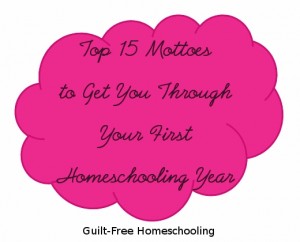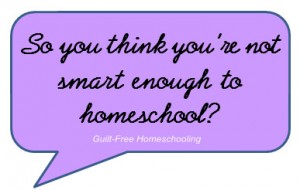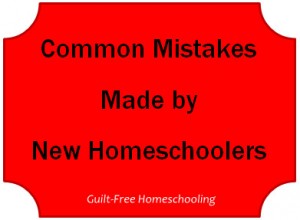I have tackled the topic of homeschooling older students while you have preschoolers around several times before, but I’ve never yet directly addressed homeschooling for preschool itself, especially when preschool marks the official beginning of schooling for your oldest child. This changes now: I am here to encourage you that you can teach your own child for preschool. You do not need an advanced degree in education to be able to effectively teach your child at home for preschool.
I have prepared a list of things that my children and I did during their preschool years that cover all of the types of activities and subjects your child will need to prepare them for their future academics. These activities may be done in any order, corresponding to your child’s interests and abilities. Progress according to your child’s abilities: if your child has difficulty understanding any given concept, set it aside for two weeks or two months while you do other activities and see what a difference that makes. Pick it up again later, or set it aside a second time, if necessary. All children learn at different rates, just like they begin to walk or talk or get teeth at different times. Faster or slower is not better, it’s just different.
Multiple activities can be done each day, if it works with your schedule and with your child’s interests. Fifteen minutes at a time may be adequate for the average preschooler, but the child may enjoy several of these short sessions throughout the day. Focus on only one activity at each session, but if your child is really enjoying the activity, you can let him continue playing with it after the formal “lesson” time is completed.
Read books to your child. Snuggle up together for special Mommy-and-me time. Use funny voices for the characters. Vary your tone to match the scene: fast and loud for the exciting parts, slow whispers for the sneaky parts, sniffling when the character is sad, bouncy and happy when the character is happy. When the book is a familiar favorite, stop periodically to ask your child questions: Where is Papa Bear going next? Why is he doing that? What will he find there? These help build your child’s memory by asking him to recall details he has learned from all of the times you have read this story in the past. Which bear is wearing the red shirt? Point to the smallest bear. Can you find a bowl on the bears’ table? Questions of this type help your child notice details and learn to identify colors, sizes, objects, etc. Why did the bears leave the house? Where did they go? What is this little girl’s name? These questions teach comprehension: read a portion of the story, and then ask the child about key elements that were just read. At first, you may want to ask questions about one page at a time, but soon your child will be able to recall details from several pages back.
Include ABC books, even though they usually have no plot or story. As a child, my personal favorite was The Nonsense ABC by Edward Lear. For my own children, their favorite was The Dr. Seuss ABC. What those books have in common are fun, rhyming poems for each letter. Lear’s “A was once an apple pie” was just as easy to remember as Dr. Seuss and his “Aunt Annie’s alligator.” The delightful poems were much more enjoyable than a simple picture book of ABC’s, although those are useful, too, as you will see in a moment.
Learning letters. Gather all the ABC books you have, and compare the pages for the same letter in each book. Linger over one letter per week or a letter every few days, until you know for sure that your child knows that letter. Use sticky-notes or home-made flashcards to label objects in your home that begin with the letter of the week, and help your child make the letter’s sound every time you see one of those objects and say its name. Banana, B, buh, buh-nana. You get the idea — and so will your preschooler. You may need to get creative on a few letters, such as Q, unless you live with a queen in a home full of quilts and have a pet quail. For X, you may need to use words that have an X in them, such as fox. The picture ABC books will come in very handy now, especially if they use several items for each letter. Don’t overlook your public library — they may have ABC books for unique topics, such as animal ABC’s or around-the-world with ABC’s.
Help your child learn to recognize a letter, no matter what font it is written in. Making a Letter Recognition Notebook is an excellent method for this. Focus on the appearance of the letters themselves, instead of what objects begin with each letter. Do one page for the upper case of a letter and another page for samples of the lower case letter. The goal here is for your child to be able to spot an a, whether it looks like a ball against a wall or like an egg underneath a tiny umbrella.
Learning numbers. Repeat the activities from the Learning Letters section above, but do them for the numbers 1-10. Draw a group of dots on the page to correspond to the number represented. Use counting books for activities similar to the ABC book activities. Once your child knows 1-10, you may add numbers up to 20, if you’d like. Your goal here is for the child to recognize each digit and immediately know how many objects that number stands for.
Learn colors. Ditto. A color-of-the-week activity will show your child all the varieties of each color. Light blue, dark blue, bright blue, dusty blue, navy blue, sky blue. Blue jeans, blue socks, blueberries, blue blanket, blue water bottle, blue crayons, blue cars, blue blocks, blue game pieces. How many blue things can you find in your home? You may be surprised!
Learn shapes. Ditto once again. The variety within each shape can be confusing at first to little ones. Is a big circle the same thing as a small circle? Are a cookie and a ring both circles even though one has stuff inside it and the other one is empty? Rectangles and triangles can be particularly tricky. Use a dollar (kids love learning with real money) as an example of a rectangle, then turn it up on end to show the child how the dollar is the same shape as a door. No more tricky rectangles! Long and skinny or short and fat, rectangles will still look mostly like a door or a dollar. Triangles have 3 sides, no matter how long or short those sides may be, and once your preschooler can count to 3, he can begin to recognize triangles. Browse through the snack cracker aisle at the supermarket for some tasty, edible geometric shapes! Careful nibblers will transform one shape into another, naming the shapes as they admire their creations and then eating their artwork.
Fine motor skills. See Preschoolers’ Educational School-time Activities for a variety of helpful activities that your child will enjoy doing and learn wonderfully useful skills at the same time.
Gross motor skills. Let your child practice on a “balance beam” made by drawing a straight line with chalk on the sidewalk or driveway. Masking tape on the floor is a good substitute indoors. When your child can do it easily without stepping off the line, switch to using a 4″ x 4″ board (any length) lying directly on the ground. When the child can walk that board easily without losing his balance, prop the board up with a brick or concrete block (or other stable item) at each end — just don’t go too high, so that the child will not be hurt if he does fall. Please stay close by your child whenever he is practicing this.
Other useful concepts. Play. Notice the weather each day. Go to the park. Walk around the block. Smell flowers. Watch an anthill. Put a bird feeder or a bird bath near a window and keep it filled so you can watch the birds and learn to identify them. Make cookies. Add a set of measuring cups to the bath toys. Visit a zoo. Watch a construction site (from a safe distance) and talk about what each man or machine is doing. Learn from life every day.
Social Skills. See Social Skills — What Should I Teach My Preschooler? for a very complete explanation.
What about school questions? Preschoolers ask questions; it’s what they do, and it’s who they are. Your homeschooled preschooler will undoubtedly ask questions about going to school: Why does my friend go to school and I don’t? When will I go to school? Can I ride on a school bus? Can I play on the school playground? Why does my storybook show kids doing things at school, but I don’t have any stories about kids who homeschool? Ah, yes, those questions.
You can share as much as you think your preschooler will understand about why you chose to homeschool, but try not to make other families look bad for not homeschooling. One way around this is to point out what vehicles are owned by the families on your block or in your neighborhood. Some have small cars, some have pickup trucks, and some have minivans. They pick the type of vehicles that they want for the things they do. Some families send their children to public school, some go to private schools, and some homeschool. Each family picks the type of school that they want for their children. Each family can also decide if they want to plant flowers around their house or raise tomatoes in their garden. They can decide if they want to have a dog or a cat or tropical fish or no pets at all. Some families choose to eat in fancy restaurants, some families get burgers at the drive-through, and some families make all their meals at home. Every family gets to make choices, and homeschooling is one thing your family has chosen.
Sometimes the trickier part of answering these questions is to show that not following the crowd can be more fun. Because you are homeschooling, you can go to the park when the other children are stuck inside the school building. This is also a good way to bring weather (good or bad) into the conversation: you can play outside on nice days instead of having to sit at a desk all day long, or you can stay inside where it’s warm and dry all day long on the cold and rainy days. Perhaps you can visit the school playground after school is over for the day or on a weekend or during the summer. Perhaps you can ride on a city bus or a church bus. I have known preschoolers who begged and begged their parents to let them go to school, only to find out that school was not the fun experience they had imagined it to be. One little boy asked his mommy if he could be homeschooled again, because all he really had wanted from school was to play on the playground, and when he was in school, the teacher only let him go out to the playground at certain times and for very short periods. Being homeschooled with his brothers was much more enjoyable.
Many children (and parents) ask about the lack of homeschooling in storybooks. I agree that there are very few books that portray education at home, but I have a sneaky way around that, too. Not all storybooks show everything that a child does every day, and not all storybooks show children going to school. Therefore, maybe, just maybe, the children in some books are homeschooling, but the story is telling about some other part of their day. Our school books were not in every room of our house — ok, sometimes, but not always. When the Bear family went for a walk to let their porridge cool down, perhaps they had been doing their lessons all morning, and now it was lunch time, and they would continue their lessons after lunch. Stories are not always about what you can see — sometimes there are also lessons to be learned in what the pictures do not show. And finding those lessons also teaches your child to think about the story and what it does and does not say.
Do I need curriculum to homeschool preschool? No. If you don’t believe me, take this quick test:
- Do you know the alphabet?
- Can you count to 20?
- Can you identify basic colors and shapes?
- Do you know how to use a pencil?
- Do you know how to use scissors?
- Can you read a child’s storybook?
If you answered Yes to 3 or more of these questions, you will probably do just fine. Use the money you would have spent on curriculum for a family zoo pass or a storage cabinet for all of the arts and crafts supplies you will accumulate in the next few years!
Preschool-aged children need foundational skills: pre-reading (recognizing letter names and letter sounds; visual distinction: recognizing differences and similarities between objects), pre-writing (small muscle skills and coordination: using fingers), and body control (large muscle skills and coordination: using arms and legs). Children who are only three, four, or five years old do not need to be able to identify nations of the world, Presidents of the United States, or the life cycle of seahorses. These tiny tots will benefit much more from spending 15 minutes cutting colored paper into confetti than they would from endless coloring pages for geography, history, science, or social studies topics. I have probably just stepped on the toes of multiple eager teachers, but please understand that your little ones will not remember very many of these superfluous lessons until they are able to read fluently for themselves. Then you can turn them loose on the library shelves and get ready to hear them recount the myriads of fascinating facts they have read.
Once when I was selling some of our outgrown books at a used curriculum fair, my customer asked if I had the teacher’s manual for the 2nd grade reading text. “No,” I replied with a smile, “I thought if I couldn’t figure out the answers to the questions in a 2nd grade reading book, I had bigger problems than the teacher’s manual could fix.” She thought about that for a few seconds and began laughing along with me. “You’re absolutely right!” And she bought the book. Teaching preschool is even easier than teaching 2nd grade reading. And you will be able to do it just fine without a teacher’s manual or fancy curriculum.
More articles related to Preschoolers are listed in Topical Index: Preschoolers.







 Guilt-Free Homeschooling is the creation of Carolyn Morrison and her daughter, Jennifer Leonhard. After serious disappointments with public school, Carolyn spent the next 11 years homeschooling her two children, from elementary to high school graduation and college admission. Refusing to force new homeschooling families to re-invent the wheel, Carolyn and Jennifer now share their encouragement, support, tips, and tricks, filling their blog with "all the answers we were looking for as a new-to-homeschooling family" and making this website a valuable resource for parents, not just a daily journal. Guilt-Free Homeschooling -- Equipping Parents for Homeschooling Success!
Guilt-Free Homeschooling is the creation of Carolyn Morrison and her daughter, Jennifer Leonhard. After serious disappointments with public school, Carolyn spent the next 11 years homeschooling her two children, from elementary to high school graduation and college admission. Refusing to force new homeschooling families to re-invent the wheel, Carolyn and Jennifer now share their encouragement, support, tips, and tricks, filling their blog with "all the answers we were looking for as a new-to-homeschooling family" and making this website a valuable resource for parents, not just a daily journal. Guilt-Free Homeschooling -- Equipping Parents for Homeschooling Success!

Recent Comments